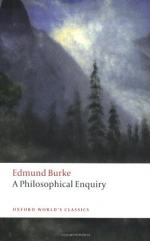
|
| Name: _________________________ | Period: ___________________ |
This test consists of 5 multiple choice questions, 5 short answer questions, and 10 short essay questions.
Multiple Choice Questions
1. What is one of the primary causes of words influencing the passions?
(a) Our sympathizing with and identifying with the passions of others.
(b) Our forceful imaginations' shaping of our emotions and desires.
(c) Our skepticism of and disdain for the emotional state of others.
(d) Our reliance on judgment and will to shape our passions.
2. What does Burke term "compounded abstract" words?
(a) Those words which stand for literary ideas.
(b) Those words which represent complex ideas.
(c) Those words which indicate natural phenomena.
(d) Those words which determine scientific nomenclature.
3. What is Burke's argument about the relation of danger to the sublime?
(a) Danger does not physically need to be present or real for an object to be sublime.
(b) Danger is never a part of any sublime object.
(c) Danger is absolutely necessary to the sublime and must be present.
(d) Danger and terror are the same thing and are equal portions of the sublime.
4. What does Burke term "simple abstract" words?
(a) Those words which stand for one straighforward idea.
(b) Those words which comprise oaths and curses.
(c) Those words which indicate political affiliations.
(d) Those words which represent human emotions.
5. What quality of mind does Burke find in women that he thinks is analogous to fragility?
(a) Curiosity.
(b) Timidity.
(c) Vapidity.
(d) Forthrightness.
Short Answer Questions
1. Why, according to Burke, is proportion not the cause of beauty in animals?
2. What are the three effects of words Burke identifies?
3. How does beauty act upon the human mind?
4. Which kinds of colors does Burke argue are essential to beauty?
5. What does NOT make certain objects or experiences affect us the way they do?
Short Essay Questions
1. Why, according to Burke, are humans readily affected by the passions of others?
2. What example does Burke use to demonstrate that perfection is not the cause of beauty?
3. What is beautiful in feeling, according to Burke?
4. What two examples does Burke use to illustrate the sublimity of succession in visual objects? Upon which principles does Burke assert these two examples operate?
5. How does Burke define ugliness, and how does Burke relate ugliness to beauty?
6. In his discussion of proportionality among human figures, what censure does Burke lay upon advocates proportion-as-beauty?
7. Why, according to Burke, is proportion not the cause of beauty in vegetation and animals?
8. How does the body react physically to emotions of love, per Burke's observations?
9. Briefly summarize the three classes of words that Burke identifies.
10. According to Burke, how does the human eye work?
|
This section contains 1,134 words (approx. 4 pages at 300 words per page) |

|




